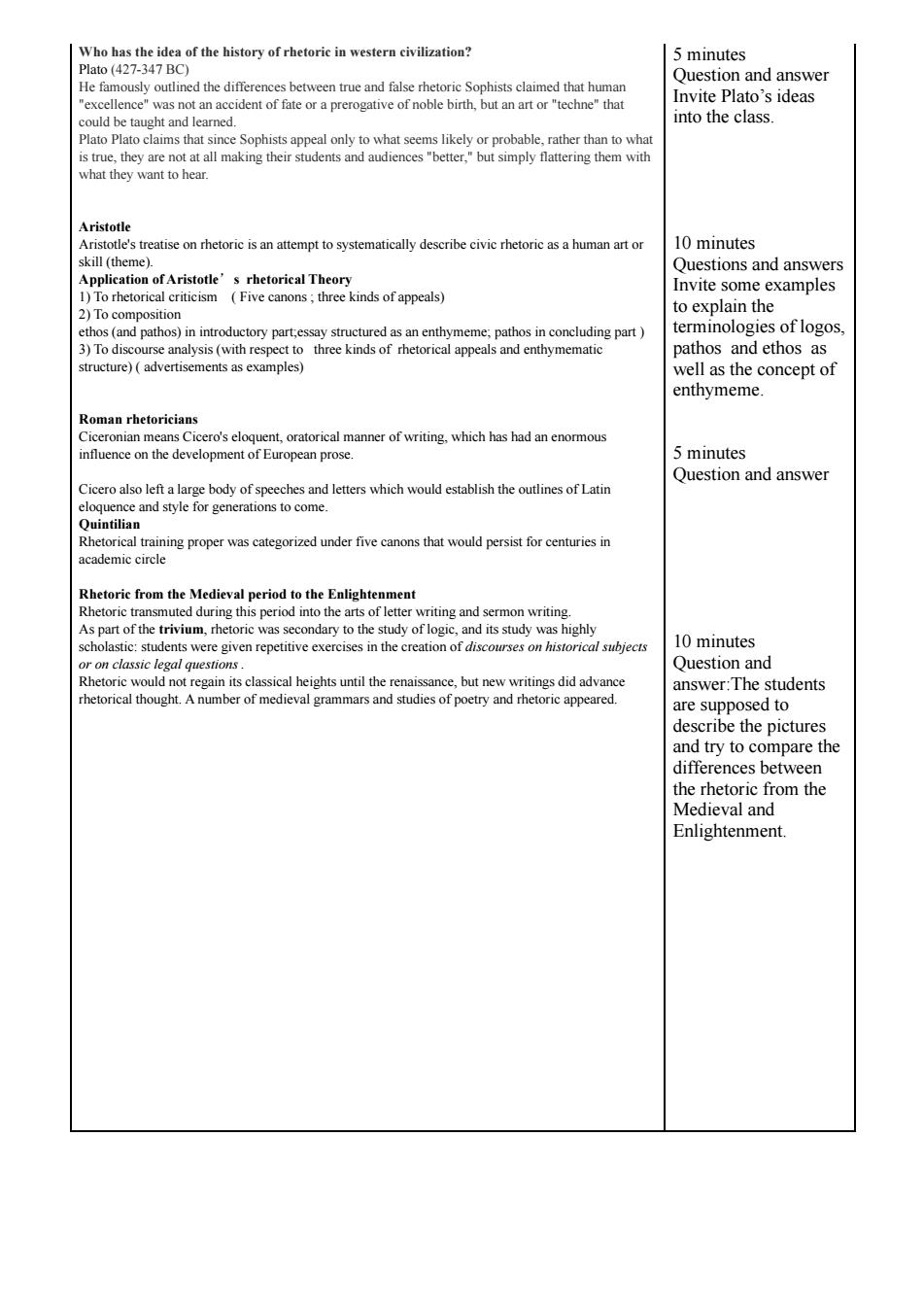正在加载图片...

Who has the idea of the history of rhetoric in western civilization? 5 minutes P1ato(427-347BC) Question and answer He famously outlined the differences between true and false rhetoric Sophists claimed that human "excellence"was not an accident of fate or a prerogative of noble birth,but an art or"techne"that Invite Plato's ideas could be taught and learned. into the class. Plato Plato claims that since Sophists appeal only to what seems likely or probable,rather than to what is true,they are not at all making their students and audiences"better,"but simply flattering them with what they want to hear. Aristotle Aristotle's treatise on rhetoric is an attempt to systematically describe civic rhetoric as a human art or 10 minutes skill (theme). Questions and answers Application of Aristotle's rhetorical Theory Invite some examples 1)To rhetorical criticism (Five canons;three kinds of appeals) 2)To composition to explain the ethos (and pathos)in introductory part;essay structured as an enthymeme;pathos in concluding part terminologies of logos, 3)To discourse analysis(with respect to three kinds of rhetorical appeals and enthymematic pathos and ethos as structure)(advertisements as examples) well as the concept of enthymeme. Roman rhetoricians Ciceronian means Cicero's eloquent,oratorical manner of writing,which has had an enormous influence on the development of European prose. 5 minutes Question and answer Cicero also left a large body of speeches and letters which would establish the outlines of Latin eloquence and style for generations to come. Quintilian Rhetorical training proper was categorized under five canons that would persist for centuries in academic circle Rhetoric from the Medieval period to the Enlightenment Rhetoric transmuted during this period into the arts of letter writing and sermon writing. As part of the trivium,rhetoric was secondary to the study of logic,and its study was highly scholastic:students were given repetitive exercises in the creation of discourses on historical subjects 10 minutes or on classic legal questions. Question and Rhetoric would not regain its classical heights until the renaissance,but new writings did advance answer:The students rhetorical thought.A number of medieval grammars and studies of poetry and rhetoric appeared. are supposed to describe the pictures and try to compare the differences between the rhetoric from the Medieval and Enlightenment.Who has the idea of the history of rhetoric in western civilization? Plato (427-347 BC) He famously outlined the differences between true and false rhetoric Sophists claimed that human "excellence" was not an accident of fate or a prerogative of noble birth, but an art or "techne" that could be taught and learned. Plato Plato claims that since Sophists appeal only to what seems likely or probable, rather than to what is true, they are not at all making their students and audiences "better," but simply flattering them with what they want to hear. Aristotle Aristotle's treatise on rhetoric is an attempt to systematically describe civic rhetoric as a human art or skill (theme). Application of Aristotle’s rhetorical Theory 1) To rhetorical criticism ( Five canons ; three kinds of appeals) 2) To composition ethos (and pathos) in introductory part;essay structured as an enthymeme; pathos in concluding part ) 3) To discourse analysis (with respect to three kinds of rhetorical appeals and enthymematic structure) ( advertisements as examples) Roman rhetoricians Ciceronian means Cicero's eloquent, oratorical manner of writing, which has had an enormous influence on the development of European prose. Cicero also left a large body of speeches and letters which would establish the outlines of Latin eloquence and style for generations to come. Quintilian Rhetorical training proper was categorized under five canons that would persist for centuries in academic circle Rhetoric from the Medieval period to the Enlightenment Rhetoric transmuted during this period into the arts of letter writing and sermon writing. As part of the trivium, rhetoric was secondary to the study of logic, and its study was highly scholastic: students were given repetitive exercises in the creation of discourses on historical subjects or on classic legal questions . Rhetoric would not regain its classical heights until the renaissance, but new writings did advance rhetorical thought. A number of medieval grammars and studies of poetry and rhetoric appeared. 5 minutes Question and answer Invite Plato’s ideas into the class. 10 minutes Questions and answers Invite some examples to explain the terminologies of logos, pathos and ethos as well as the concept of enthymeme. 5 minutes Question and answer 10 minutes Question and answer:The students are supposed to describe the pictures and try to compare the differences between the rhetoric from the Medieval and Enlightenment